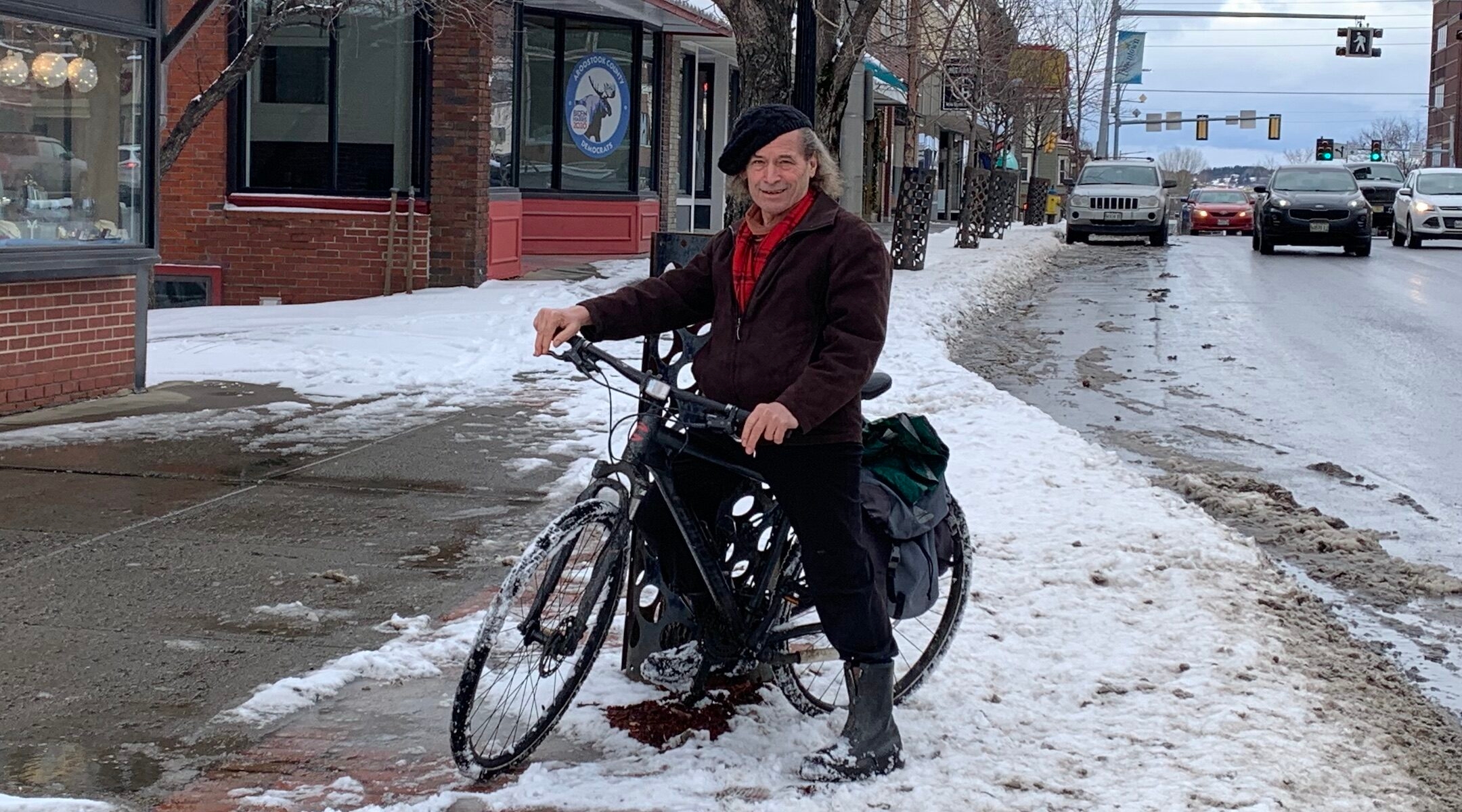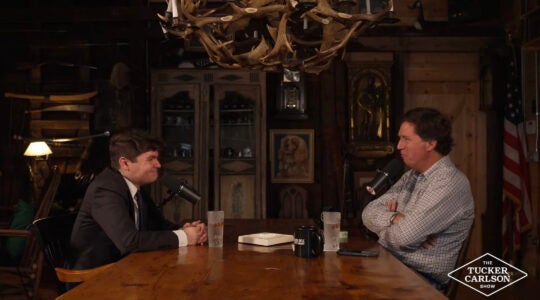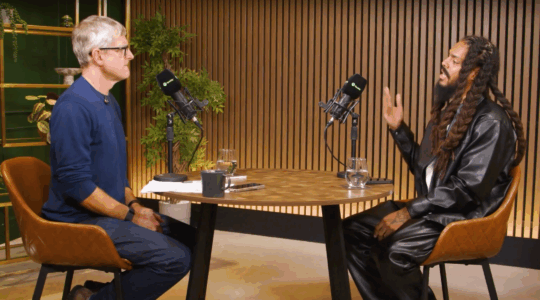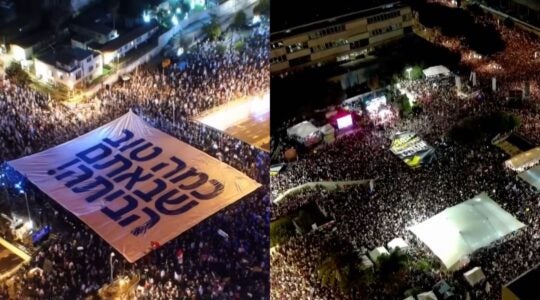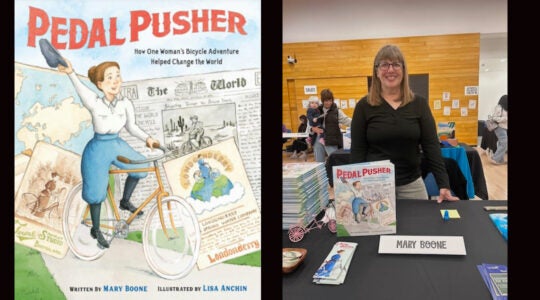PRESQUE ISLE, Maine (JTA) — In this speck of a city lives an artist who starts his mornings swathed in a tallit and tefillin, spends most of his days making biblically inspired works of art and whiles away the evenings picking out Schubert sonatas on the piano.
Raphael Gribetz has lived in Presque Isle since 1985, when he and his late wife moved here from the even more remote Portage Lake (population: 391) so she could pursue a degree in social work.
Presque Isle is hundreds of miles and a world away from the Maine of postcard-perfect lighthouses and craggy shorelines, and it’s an unlikely destination for a yeshiva-educated man born into an Orthodox family of seven children in New York City in 1952. But Gribetz has been defying expectations for much of his life.
As a young man, he defied his parents’ wishes and gave his life to his art, secretly dropping out of Yeshiva University because it didn’t have an art program and enrolling instead at the City College of New York, where he went on to earn an undergraduate degree in English and an MFA.
As a young artist, he abandoned life in the capital of the art world for a rural backwater. Despite his commitment to daily Jewish practice, he settled down in a city with only the barest hint of Jewish life and then unexpectedly wound up as the community’s spiritual leader. Despite making art saturated with Old Testament imagery, perhaps his most viewed work is a gruesome crucifix commissioned by a Catholic priest with whom he would vacation in the Maine woods.
“I guess I’m a purist,” Gribetz said. “But I’ve suffered. And I continue to suffer.”
With his ready smile and spry bearing, you wouldn’t immediately know it.
At 68, Gribetz’s days are spent engaged in pursuits that have given his life a sense of purpose since he was young — music, sculpture and painting. Locals, who know him as Ray, inevitably mention his dedication to physical fitness and the grueling running regimen he would keep up the year round, even through the brutal Maine winter, before two hip replacements forced him to switch to cycling. Gribetz outfits his bike with studded tires so it can serve as his primary means of transportation even in the snow. He proudly boasts that he hasn’t filled the gas tank in his minivan in months.
His smile comes easily. When something amazes him — a not infrequent occurrence — he’ll remark “wow” and drag out the syllable for several beats. But the tears come easily, too — and invariably when the conversation turns to his wife, Nilda, who died of a heart ailment in 2015. Gribetz will look down and grow quiet for a moment, and when he looks up again there will be wet streaks around his eyes.
“Tragedy,” Gribetz said, “has followed me my whole life.”
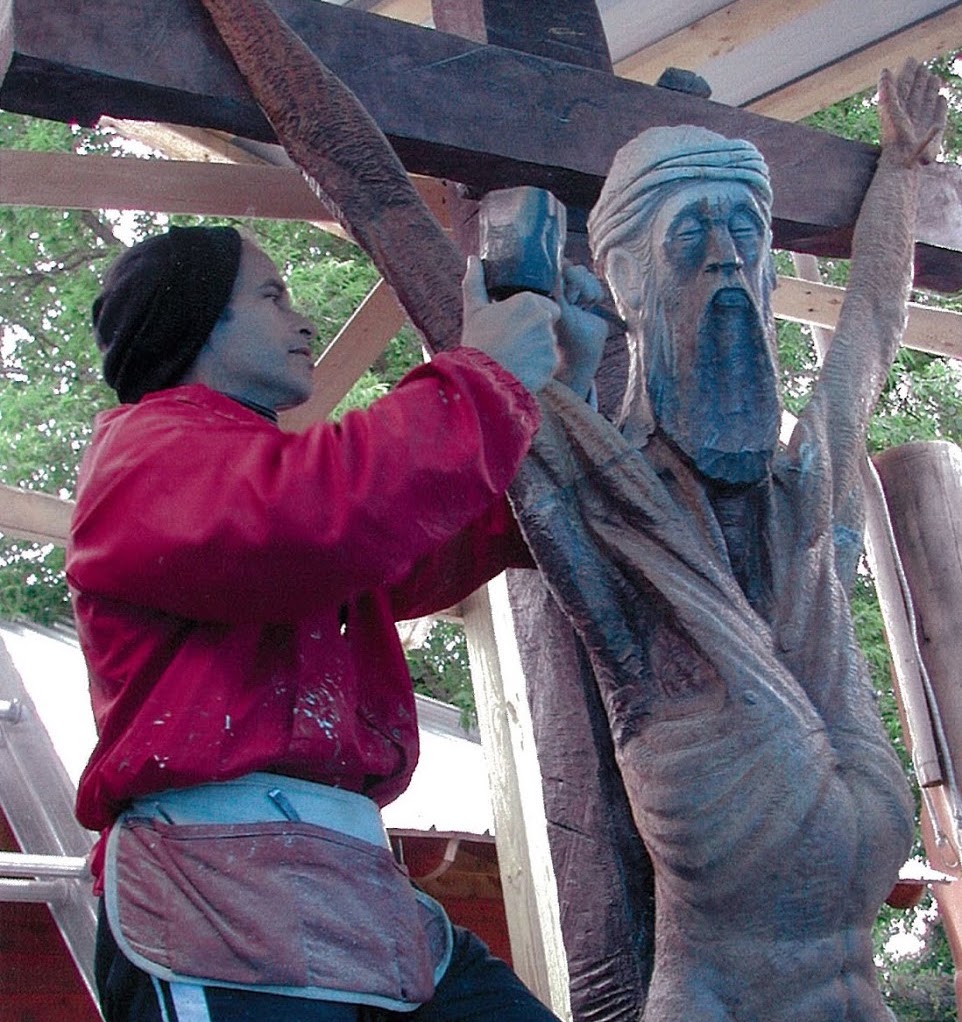
Gribetz at work on a crucifix for the local Catholic parish. (Courtesy of Gribetz)
His Orthodox childhood, spent in the Riverdale section of the Bronx, New York, was a difficult one. His mother’s family fled Germany after Kristallnacht and suffered from what Gribetz and his siblings describe as an acute case of survivor’s guilt. His father, a physician who grew up in a rigidly Orthodox family in Brooklyn and could chant the weekly Torah portion without preparation, would sometimes barter for treatment with destitute Holocaust survivors.
The teachers at the Manhattan yeshiva Gribetz attended had numbers tattooed on their arms and a penchant for violence. None of the Gribetz siblings identify as Orthodox today.
“Religion was never fun,” said Gribetz’s younger brother, Jonathan, a retired television commercial producer who lives in Austin, Texas. “They made it awful in the yeshiva.”
Gribetz says the joke back then was that yeshiva kids got beat up three times a day — by the roughnecks they passed on the way to school, by their teachers and by their parents when they got home. Except it wasn’t a joke.
“You’d come home, mother would say, ‘Why are you such a mess?’ You’d say fighting. And then she’d hit you,” he said.
Gribetz’s parents were unconventional. They composted and grew their own vegetables long before it was the hip thing to do. Sometimes his mother, who grew up in a small rural village, would go to the butcher and bring home a live chicken and let it run around. After World War II, the couple lived for a time in Paris, where three of Gribetz’s older siblings were born, and they ran with a bohemian crowd. Gribetz’s father even befriended the abstract expressionist Jackson Pollock when the family rented a summer place next to his in the Hamptons. A photo of Gribetz as a baby being held by the famed painter is featured on his website.
“There was this side to my parents that was artistic, that was kind and that was worldly, and [there was another side] that was also very difficult and very hard,” Gribetz said. “And we had to navigate that.”
Rough as it was, the yeshiva was also where Gribetz discovered he had talent. On Fridays, the school would relax for a bit in anticipation of the coming Jewish sabbath, passing out crayons and paper for the kids to doodle. One week Gribetz did a drawing of a rooster, and a teacher known for being particularly harsh stopped to admire it.
“He looked down on it and he said, ‘You did this?” I said, ‘Yeah.’ And then he walked away,” Gribetz recalled. “And I knew. If Mr. Gertler stopped in front of my drawing, I had something that would stop people.”
Despite the difficult home environment, Gribetz lived with his parents well into his 20s as he tried to make his way as an artist in New York. For a time he couldn’t afford an apartment and took a job as a night cleaner in office buildings, where he would catch a few hours of sleep if he finished his work early.
In the late 1970s, he was working as a taxi driver when he met a Puerto Rican immigrant and mother of three who would become his wife. Gribetz dropped Nilda off early one evening and then, as luck would have it, took the call to bring her home later that night. (Nilda eventually converted to Judaism with a Conservative rabbi in Massachusetts and served as president of the Presque Isle synagogue for a decade.)
“I got the same person in my cab twice the same night, and I said it was bashert,” Gribetz said.
But the financial pressures of the artists’ life in the city took its toll. One rainy morning, Gribetz was walking through Greenwich Village when he noticed a friend, a man who dressed in women’s clothing and went by the name Diane, sound asleep on a mattress someone had thrown out a window on to the street.
“Here I am standing above Diane and she’s sound asleep,” Gribetz said. “And I said, I got to get out of here. I’m going to die here.”
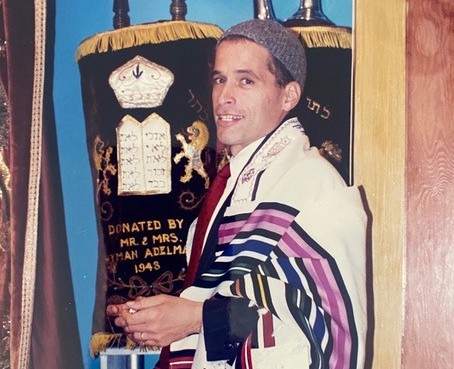
Gribetz leads High Holiday services in Presque Isle. (Courtesy of Toby Adelman)
Seeking an easier life, Gribetz and Nilda went north, first to Provincetown, Massachusetts, and later to Maine, where he still struggled to make a living. For a time he taught English at the Presque Isle campus of the University of Maine. He also took carpentry gigs and occasionally worked at McDonald’s.
Presque Isle is not the Maine of popular imagination. More than four hours north of Portland, Aroostook County is vast and sparsely populated, known to Mainers simply as “the county.” There are no lighthouses or quaint seaside communities, only sprawling wilderness and potato fields stretching to the horizon. With its 9,000 residents and university outpost, Presque Isle is a veritable metropolis by county standards, boasting a couple blocks of downtown commerce and a Walmart.
Gribetz lives in a tiny two-bedroom home three blocks from Main Street, up a hill just past the bike path. On a chilly October evening, he greeted visitors dressed in a flannel shirt buttoned to the neckline and turquoise sweatpants tucked into mismatched socks, one of which had an enormous hole in the heel. Inside, a wood stove blazed beneath the beamed ceiling of the main space, which does triple duty as a living room, dining room and music studio. A small upright piano is wedged into one corner, an electronic one into another. Three large heating implements take up much of the remaining floor space.
Gribetz’s art is everywhere. Two glazed ceramic sculptures on a shelf depict Adam and Eve. An abstract painting on the wall shows what appear to be books on a shelf. A drawing of an Israeli soldier wrapped in tefillin has the man gazing toward the heavens with an M-16 on his back, the gun oriented skyward as well. And in the back room that doubles as Gribetz’s studio, he’s at work on a sculpture of Abraham trying to console Isaac after nearly sacrificing him at God’s command.
Gribetz is not conventionally religious, neither keeping the Sabbath nor the dietary laws. But Judaism infuses every aspect of his being, from his art to his spiritual practice to the Brooklyn whaddya-talking-about cadence of his speech. He dons tefillin before he meditates each morning, studies Torah late into the night, and liberally sprinkles Hebrew expressions and biblical quotations into his soliloquies on life and art.
“He uses his religion for survival,” Gribetz’s younger brother Jonathan said. “I think if he didn’t have that, I don’t know how he would function. I think it’s very important to him for surviving.”
But as befits a man who lives in a city where he is practically the only Jew, Gribetz’s Judaism brooks none of the traditional boundaries. He has developed close friendships with local Christian clergy with whom he studies Torah and spent years learning Buddhist meditation, driving regularly to Canada and across New England to attend classes and retreats.
“Judaism is a path for us to be compassionate to everyone,” Gribetz said. “It’s not a thing in and of itself. What is a thing in of itself is how we feel toward other human beings. I was blessed in the most difficult times of my life to have that connection.”
When Gribetz first arrived in Presque Isle, there was a small but active Jewish presence, which isn’t as crazy as it sounds. Jewish families have lived for 100 years in the handful of small communities that line the two-lane state road that snakes north through the county from Houlton, the last stop on I-95 before the Canadian border. A 1955 document on the website of the Documenting Maine Jewry project lists dozens of Jews in small towns from Houlton to Fort Kent, with the largest number in Presque Isle.
With his yeshiva background, Gribetz soon took on the role of spiritual leader of the Aroostook Hebrew Community Center. When the synagogue was defaced with swastikas in 1998 just prior to Rosh Hashanah, the Boston Globe quoted Gribetz calling the vandalism “an American affront.” Hundreds of locals came to holiday services that year to show support.
Over the years, the community met only on Jewish holidays. Sometimes Gribetz would lead Yom Kippur services for 30 people. Sometimes just two would show. Despite the ample financial resources among some Jews in the area, the building gradually fell into disrepair.
“Ray was the one who really was keeping the heart and soul of the community together,” said Toby Adelman, who grew up in nearby Mars Hill and whose grandfather, Hiram Adelman, hosted the meeting creating the synagogue at his home in 1937. “Even when the synagogue was too cold in the winter because we didn’t want to heat the whole place, he would have study sessions at his place. He was the source.”
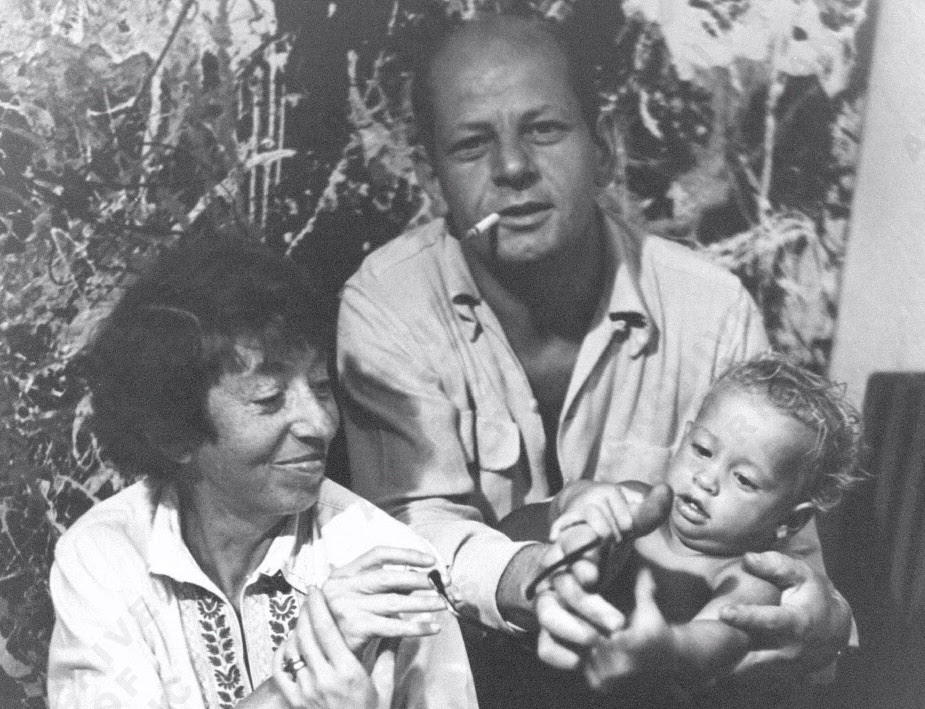
Legendary artist Jackson Pollock holds a young Raphael Gribetz. (Courtesy of Gribetz)
Local Jews attribute the synagogue’s closure to the long decline in the area’s Jewish population. When Adelman was young, High Holiday services regularly drew hundreds of people. But Gribetz says there was a more immediate cause of its closure.
Before Rosh Hashanah in 2012, Gribetz went to turn on the water before services and found it wasn’t working. Someone suggested having a pail of water on hand so people could flush the toilet, but Gribetz found that solution to be more than disrespectful — a desecration of God’s name, he called it, and he canceled services at the synagogue. They were never held there again.
“I’m not as compassionate as I’d like to be, and part of the demise of the shul is my fault,” Gribetz said. “Some of the people that were close to the shul and I supported in terms of their Jewish faith clung to me. So what are we going to do now? How are you going to lead us now without the shul? I’ve been doing it for 20 years. They hadn’t done anything to lead themselves. I was fatigued in a sense.”
With little Jewish life to speak of in Presque Isle, Gribetz formed his deep relationships with the Christian clergy — he could bond with them over a shared love of biblical text.
“I think he had that kind of hunger for conversation and study, and you can’t just have that with anyone,” said Robert Grove-Markwood, who led the Congregationalist church in Presque Isle for 25 years and struck up a friendship with Gribetz shortly after assuming the post in 1988. “His parishioners he can teach, but he’s not going to sit down and talk with those folks the same way he can with someone who has dedicated time to the study of text.”
Grove-Markwood would sometimes spend evenings listening to Gribetz play piano or studying some text together. When he left the church, parishioners gave him one of Gribetz’s paintings as a gift. Several other pieces of Gribetz’s art now adorn Grove-Markwood’s home, including sculptures inspired by Jonah emerging from the fish and Isaac lovingly embracing the ram that was sacrificed in his stead.
“That’s midrash in Indiana limestone,” Grove-Markwood said of the latter piece, using the Hebrew word for biblical interpretation. “It’s like, wow.”
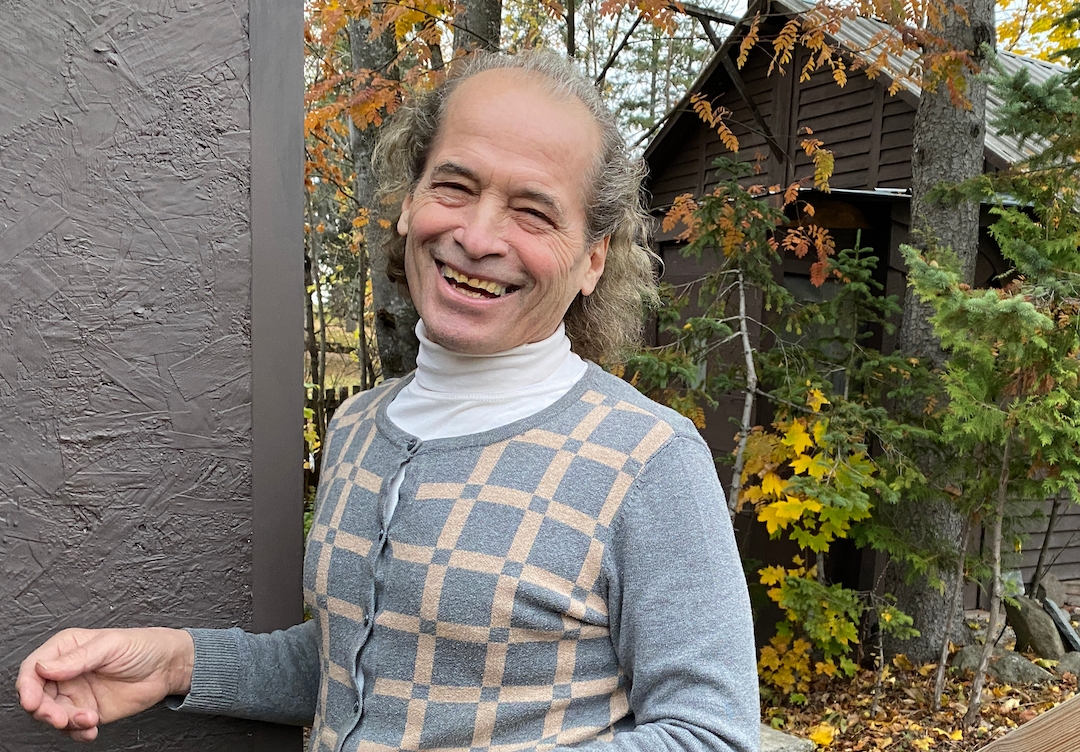
Gribetz at his Presque Isle home. (Janine Strong)
After Nilda’s death, Gribetz channeled his grief into his art, which in turn led to a rare exhibition in the summer of 2017, “A Search for Truth,” which ran at the BTS Center in Portland, a training center for faith leaders that Grove-Markwood led after leaving Presque Isle.
“The powerful intensity of my grieving was devastating to my capacity to withstand wave after wave of intense weeping,” Gribetz wrote in a brief introduction to the show. “Only through the amazing grace of God was I able to endure the unending storm of grief. In my new awareness of God’s grace, I find myself pursuing God. ‘God, where are you?’ I ask.”
Suffering is a recurrent theme in Gribetz’s art. His subjects are often disfigured with grief, their faces contorted in pain and their limbs set at impossible angles. That may explain why Thomas Lequin, the former priest at the local Catholic parish and another of Gribetz’s close friends in town, asked him to sculpt a crucifix for the church in 2002. Gribetz rendered Jesus in graphic fashion, the blood streaking down his face and torso. Not everyone in the church appreciated it, but Lequin gave Gribetz no specifications for the sculpture, leaving it up to his intuition.
“A lot of people like nice resurrected stuff, and rightly so,” Lequin told JTA. “But at the same time, he died a horrible death. And I don’t care how much you want to paint it up, it was not a nice thing. That’s what I thought about it. I liked the graphic nature of it, but it was also tastefully done. It showed a man suffering, and that’s never pleasant to see someone suffering like that. But it’s the reality of it.”
Gribetz worked on the sculpture for months, and parishioners would regularly stop by to check on his progress. When it was finished, Gribetz went down to the church to watch the installation. When the installer returned to the church after a break, he knelt before Gribetz’s depiction of Jesus on the cross. Even now, Gribetz tears up as he describes the scene.
“I saw my work trying to bring God’s presence here as much as I can, to be as vivid as I can,” he said. “The Torah is filled with great stories of God’s presence, of God’s disappointment, of strife between being an ‘am kedushah’ [holy nation], what that takes for us to give examples of holiness, how we work with all the nations of the earth, and how humanity — we’re all the same and we’re all equal and we all have to love each other. That’s been my work.”
JTA has documented Jewish history in real-time for over a century. Keep our journalism strong by joining us in supporting independent, award-winning reporting.
